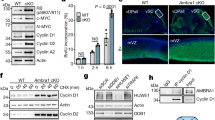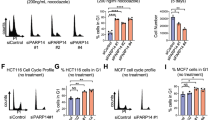Abstract
Cyclin G is one of the earliest p53 target genes to be identified, but its function in the p53 pathway has been elusive. Although the precise mechanisms of cyclin G in this novel network have not been explored, recent studies have demonstrated that cyclin G is a key regulator of the p53-Mdm2 network. Here we present evidence that cyclin G-mediated p53 regulation is dependent upon the status of ataxia-telangiectasia mutated (ATM) protein, which activates p53 in response to DNA damage. Abrogation of cyclin G enhances p53 accumulation and phosphorylation of p53 at the Ser-15 residue, resulting in cell cycle arrest. Ectopically expressed cyclin G significantly reduces the steady-state levels of p53 as well as that of phosphorylated p53 at Ser-15 after DNA damage in normal human dermal fibroblasts containing normal ATM. However, cyclin G does not cause similar reductions in p53 levels in ATM-mutated cells. We also show that translocation of cyclin G to the nucleus requires functional ATM. Thus, our findings identify a new role of cyclin G in ATM-dependent p53 regulation and in cell cycle regulation during DNA damage.
This is a preview of subscription content, access via your institution
Access options
Subscribe to this journal
Receive 50 print issues and online access
$259.00 per year
only $5.18 per issue
Buy this article
- Purchase on Springer Link
- Instant access to full article PDF
Prices may be subject to local taxes which are calculated during checkout




Similar content being viewed by others
References
Alarcon-Vargas D and Ronai Z . (2002). Carcinogenesis, 23, 541–547.
Canman CE, Lim D, Cimprich KA, Taya Y, Tamai K, Sakaguchi K, Appella E, Kastan MB and Siliciano JD . (1998). Science, 281, 1677–1679.
Chen X . (2002). Dev. Cell, 2, 518–519.
Giaccia AJ and Kastan MB . (1998). Genes Dev., 12, 2973–2983.
Jensen MR, Factor VM, Fantozzi A, Helin K, Huh CG and Thorgeirsson SS . (2003). Hepatology, 37, 862–870.
Kimura SH, Ikawa M, Ito A, Okabe M and Nojima H . (2001). Oncogene, 20, 3290–3300.
Maya R, Balass M, Kim ST, Shkedy D, Leal JF, Shifman O, Moas M, Buschmann T, Ronai Z, Shiloh Y, Kastan MB, Katzir E and Oren M . (2001). Genes Dev., 15, 1067–1077.
Ohtsuka T, Ryu H, Minamishima YA, Ryo A and Lee SW . (2003). Oncogene, 22, 1678–1687.
Okamoto K and Beach D . (1995). EMBO J., 13, 4816–4822.
Okamoto K, Kamibayashi C, Serrano M, Prives C, Mumby MC and Beach D . (1996). Mol. Cell. Biol., 16, 6593–6602.
Okamoto K, Li H, Jensen MR, Zhang T, Taya Y, Thorgeirsson SS and Prives C . (2002). Mol. Cell, 9, 761–771.
Okamoto K and Prives C . (1999). Oncogene, 18, 4606–4615.
Reimer CL, Boras AM, Kurdistanni SK, Garreau JR, Chung M, Aaronson SA and Lee SW . (1999). J. Biol. Chem., 274, 11022–11029.
Shimizu A, Nishida J, Ueoka Y, Kato K, Hachiya T, Kuriaki Y and Wake N . (1998). Biochem. Biophys. Res. Commun., 242, 529–533.
Siliciano JD, Canman CE, Taya Y, Sakaguchi K, Appella E and Kastan MB . (1997). Genes Dev., 11, 3471–3481.
Skotzko M, Wu L, Anderson WF, Gordon EM and Hall FL . (1995). Cancer Res., 55, 5493–5498.
Smith ML, Kontny HU, Bortnick R and Fornace Jr. AJ . (1997). Exp. Cell Res., 230, 61–68.
Tamura K, Kanaoka Y, Jinno S, Nagata A, Ogiso Y, Shimizu K, Hayakawa TT, Nojima H and Okayama H . (1993). Oncogene, 8, 2113–2118.
Zauberman A, Lupo A and Oren M . (1995). Oncogene, 10, 2361–2366.
Zhao L, Samuels T, Winckler S, Korgaonkar C, Tompkins V, Horne MC and Quelle D.E . (2003). Mol. Cancer Res., 1, 195–206.
Acknowledgements
We thank T Ouchi for helpful discussion, the technical help of K-T Kim, and W Wong and M Meyer for proof-reading the manuscript. This work was supported in part by Grants CA85681 and CA78356.
Author information
Authors and Affiliations
Corresponding author
Rights and permissions
About this article
Cite this article
Ohtsuka, T., Jensen, M., Kim, H. et al. The negative role of cyclin G in ATM-dependent p53 activation. Oncogene 23, 5405–5408 (2004). https://doi.org/10.1038/sj.onc.1207693
Received:
Revised:
Accepted:
Published:
Issue Date:
DOI: https://doi.org/10.1038/sj.onc.1207693
Keywords
This article is cited by
-
p53 and cyclin G cooperate in mediating genome stability in somatic cells of Drosophila
Scientific Reports (2017)
-
miR-27b synergizes with anticancer drugs via p53 activation and CYP1B1 suppression
Cell Research (2015)
-
Evolutionary change driven by metal exposure as revealed by coding SNP genome scan in wild yellow perch (Perca flavescens)
Ecotoxicology (2013)
-
Time- and concentration-dependent changes in gene expression induced by benzo(a)pyrene in two human cell lines, MCF-7 and HepG2
BMC Genomics (2006)
-
Cellular processing of platinum anticancer drugs
Nature Reviews Drug Discovery (2005)



